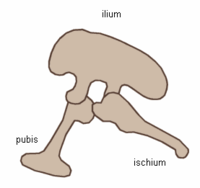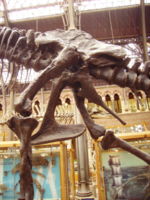Saurischia
2008/9 Schools Wikipedia Selection. Related subjects: Dinosaurs
| Saurischians Fossil range: Late Triassic - Late Cretaceous (non-avian) |
||||||||||
|---|---|---|---|---|---|---|---|---|---|---|
 Saurischian pelvic structure (left side)
|
||||||||||
| Scientific classification | ||||||||||
|
||||||||||
| Suborders | ||||||||||

Saurischia (pronounced /sɔˈrɪskiə/, from the Greek sauros (σαυρος) meaning 'lizard' and ischion (ισχιον) meaning 'hip joint') is one of the two orders/branches of dinosaurs. In 1888, Harry Seeley classified dinosaurs into two great orders, based on their hip structure. Saurischians ('lizard-hipped') are distinguished from the ornithischians ('bird-hipped') by retaining the ancestral configuration of bones in the hip. All carnivorous dinosaurs (the theropods) are saurischians, as are one of the two great lineages of herbivorous dinosaurs, the sauropodomorphs. At the end of the Cretaceous Period, all non- avian saurischians became extinct. This is referred to as the Cretaceous-Tertiary extinction event.
The saurischian lineage diverged from the ornithischians in the late Triassic Period, and retained a three-pronged pelvic structure, with the pubis pointed forward, until some advanced forms in the group Maniraptora reversed this, in parallel with the ornithischian condition. The ornithischians evolved a new hip structure, with the pubis rotating caudally, to become parallel with the ischium, often also with a forward-pointing process, giving a four-pronged structure. This hip structure is similar to that of birds, and so ornithischians are termed 'bird-hipped' dinosaurs, while the saurischians are 'lizard-hipped'. The true bird-hip possessed by modern birds evolved independently in the lizard-hipped theropods in the Jurassic Period, an example of convergent evolution.
While Seeley's classification has stood the test of time, there is a minority theory, first popularized by Robert Bakker in The Dinosaur Heresies that separates the theropods into their own group and places the two great groups of herbivorous dinosaurs (the sauropodomorphs and ornithischians) together in a separate group he named the Phytodinosauria ('plant dinosaurs') (Bakker), or Ornithischiformes (Cooper).
Taxonomy
Classification
- Order Saurischia
- Eoraptor
- Guaibasaurus
- Infraorder Herrerasauria
- Suborder Sauropodomorpha
- Infraorder Prosauropoda
- Infraorder Sauropoda
- Suborder Theropoda
- Infraorder Carnosauria
- Infraorder Ceratosauria
- Infraorder Deinonychosauria
- Infraorder Ornithomimosauria
- Infraorder Oviraptorosauria
Additionally, the genera Teyuwasu and Agnosphitys may represent early saurischians, or more primitive non-dinosaurs.
Phylogeny
The following cladogram is adapted from Weishampel et al., 2004.
| Saurischia |
|
||||||||||||||||||||||||||||||||||||||||||
|
|